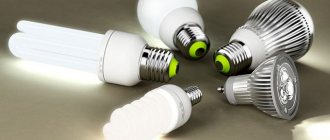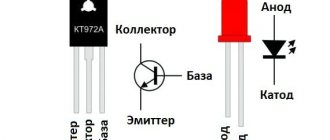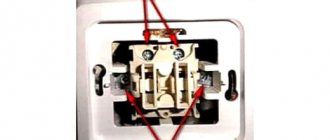Warning!
But let us remember firmly: without the qualifications and skills of an electrician, without special tools and protective equipment, it is impossible to carry out work on ANY electrical equipment, including household electrical appliances! You can only use the standard controls without disassembling anything.
Electric shock will not warn you in advance, and its consequences are unpredictable and can be long-lasting. Especially if you have been drinking alcohol. Already from a shot of vodka, a person’s electrical resistance drops 1000 times, and an otherwise harmless pinch can turn out to be a fatal blow.
Dimming LED lamps: when does flickering occur?
It should be clearly understood that not all designs of LED lamps are subject to an external method of controlling their brightness from a dimmer, but only those that are specially designed for such operating conditions.
A dimmable lamp has a special designation on the packaging in the form of a sign of a rotary control knob - a dimmer.
If it is not marked and is missing, then there is no point in connecting a simplified model: it will begin to flicker, because it is not adapted to such low-voltage operating conditions.
However, if you want to regulate the luminous flux of LED diodes, you can use a special driver design with a built-in dimmer.
Now manufacturers have even begun to produce a universal dimmer for energy-saving and LED lamps Dimax 544 plus.
How effectively it works, we will not discuss here. I tried to give a general idea of how to get rid of flickering LED lamps that are not suitable for dimming, but are connected for it.
Ice lamps not designed to operate on a dimmer can create flickering lighting. They simply do not have enough voltage level to operate a low-quality power driver.
Option 1: The light bulb in the stationary lamp is blinking
First of all, why are the lights blinking in the apartment? If one light bulb in a stationary lamp (or one section in a chandelier) blinks, then either it, or the switch, or the wiring section between them is faulty.
Let's listen to the switch, with a closer ear. Do you hear something like a faint crackling or hissing sound? If yes, bad contact. The switch, however, may be in good working order, but dirt has just gotten onto the contacts or into the spring. Unscrew the flashing light bulb and quickly click the switch several times. Please note - with the light bulb unscrewed, no load! Otherwise, the already weakened contacts may burn out, and the switch will completely deteriorate. Screw in the light bulb again. Did it help? If not, move on.
We replace the flashing light with a known good one. If there is no spare, temporarily unscrew it from somewhere. Is that how it blinks? Well, the problem is in the wiring or in the electrical fittings of the lamp. This is already the work of the master.
Fixing problem #1
Once you understand why the energy-saving light bulb blinks when the switch is off, it is easy to propose a solution to the problem:
- Open the microcurrent circuit by turning off the backlight on the switch.
- Change the parameters of the backlight power circuit so that the current is insufficient to charge the capacitor.
- Wrap the currents in a circuit with less resistance.
- Replace the switch with a model without backlight or install other lamps.
Why does the LED light blink when the lights are off?
If we are talking about a chandelier with several arms, there is another way - you can screw an incandescent lamp into one of the arms.
The method is quite simple, but it works. If single light bulbs flicker, you will have to deal with the phenomenon using other methods. There probably won’t be any problems with replacing switches and lamps, but there may be problems with other methods.
Removing the backlight
Illuminated switches have a circuit board that contains an LED or small neon light, a resistor, and contacts (usually springs). This board is located under a small plastic cover on the back of the switch body. To get to it, you need to disassemble the switch.
We disassemble the switch to get to the cover
The cover can be pryed off with a fingernail or a screwdriver. Having removed it, we find a board on the back side.
There is a small backlight board installed on the back of the cover.
We take out this board. It is not secured by anything, we just pry it up and remove it from the clamps. We install the cover without the board, assemble the switch and check its functionality. Everything should work, except for two things: the backlight does not light up when the lights are off and the energy-saving or LED lamps do not blink.
Leave the backlight on while changing the power circuit parameters
Not all backlit switches are made using circuit boards. More budget models are made simpler: a resistance is soldered to the diode and this circuit is installed in parallel with the switch keys (as in the photo below).
The backlight on the switch can be assembled like this
In this case, you can unsolder/bite out the LED and resistor and get a regular switch without backlighting. But you can change the parameters of this circuit so that the backlight will work, but the lamps will not blink or light up when the lights are off. To do this, you will have to replace the resistor - set the resistance:
- not less than 220 kOhm, if the backlight is with a neon lamp;
- at least 470 kOhm or 680 kOhm with LED backlighting (selected locally).
Besides? A 1N4007 diode is built into the circuit behind the resistance, with the cathode facing the resistor. We solder the second input of the diode to the backlight lamp. As a result, the power circuit will look like the figure below.
Advanced backlight circuit
To eliminate the flickering of the lamps and maintain the backlight on the switch, unsolder the old resistor and install a new one along with the diode. After which the switch can be assembled and put in place.
Eliminate flickering of lamps when the lights are off
In most cases the problem goes away. If the lamp is still blinking, you need to replace the resistor with a larger one. This happens rarely, but...
We create a circuit with lower resistance parallel to the lamp
If you connect a resistor parallel to the lamp, the current will flow to heat it up, the lamp capacitor will remain without charge and will not blink. The resistor is usually taken at 50 kOhm and power 2 W, wires are soldered to it, and then insulated, leaving only two wires outside for connection. You can wrap it with electrical tape or use heat shrink tubing.
First, the junction of the conductors and resistance legs is insulated, then another layer of insulation is applied, which also covers the resistor. The currents are small, and if there is any heating, it will be very insignificant, but with such double-layer insulation, this modification is safe.
We carefully isolate all areas without insulation
There are two ways to install this resistor: in the junction box or directly on the lamp. It is only important that it is connected parallel to the lamp.
Here you can see where the resistor needs to be connected, but you shouldn’t do it as in the photo: the terminals and the resistor body are not insulated - electric shock is possible when replacing the lamp
Connect the previously prepared insulated resistor to the same places - this is much safer. In the distribution box, the connection is similar. You need to find two wires that go to the lamp, and connect additional conductors to the same contacts. After this modification the light will not blink. But if you are not good at electrics, be very careful.
We remind you once again that all this work must be carried out with the power switched off in the panel.
Option 3 (global): The light flashes throughout the entire apartment
- Let's say there is at least one room in the apartment where the light does not blink . Then, most likely, the problem is in the “dose” - the distribution box inside the apartment. There is no need to go there yourself, but your information may be useful to an electrician.
- Flashes “the whole apartment? “We look out the windows. If it also blinks in neighboring houses, there is a fault at the substation or in the main supply cable - feeder. You need to inform the emergency utility service or directly to the power grid dispatcher - the number will be given at the help desk.
- Do the lights in neighboring houses burn smoothly? Let's look into the entrance - how is it there, is it blinking? Let's ask the neighbors. Is it flashing at everyone’s entrance? The feeder from the substation to the house is faulty, or the equipment of the input switchboard in the house or the electrical distribution network in it. Here you definitely need to inform the municipal emergency department - house electrical networks are under their jurisdiction.
- Finally, is it only yours that is blinking? Perhaps the fuse (plug) of your apartment in the electrical panel on the staircase is faulty. If it is available and there is a spare, you can replace it. But! If the shield is sealed, DO NOT OPEN it under any circumstances! There will be problems and sanctions with the energy sector later. And for the same reason – plus fire and electrical safety – DO NOT INSTALL A “BUG” CORK with a homemade wire fuse. A fire caused by a bug is a very common situation.
Reasons for current accumulation on a capacitor
Despite the accumulation of electricity in the filter capacitor, in most cases it remains operational. And the very presence of current simply indicates a problem.
Its source can be 3 reasons:
- Backlight lamps located on the switch.
- Presence of leakage currents.
- The exhausted life of the lamp itself and its individual elements. For example, the starter of a fluorescent energy-saving lamp.
To solve the problem quickly and at low cost, you should take a closer look at the causes of flickering/blinking.
Reason #1 - switch backlight lamps
The industry is trying to increase the competitiveness of its products by making them more functional and convenient.
For this purpose, many switches are equipped with backlight lamps, which help people easily find their location in the dark. But the way they are connected to the circuit often allows current to flow to the filter capacitor, which will cause blinking.
The photo shows filter capacitors. They are able to accumulate a certain amount of current and supply it to the lamp starting circuit
This happens due to the fact that the backlight lamp is installed parallel to the switch itself. This is done so that this element can always perform its duties.
But when the switch contacts are open, all available electric current flows to the backlight. And then a small amount of it falls on the energy-saving lamp, which leads to abnormal operation of the filter capacitor. This phenomenon is so common that it has become the main cause of blinking.
Using an incandescent lamp of any wattage or additional resistance in the circuit are simple ways to troubleshoot the problem. The photo shows the last option
It is easy to combat this cause, and there are several simple methods from which a person can choose the appropriate one.
Method #1 . Replacing the switch with a product without a backlight. It is not expensive and the problem can be fixed quickly.
Method #2 . Disconnect the backlight wires - that is, you just need to break the power circuit by cutting the necessary wires. Any specialist or the user himself can do this in a few minutes if he has the appropriate skills. This solution is considered the most inexpensive, but you will have to sacrifice the lighting.
Method #3 . Add an incandescent lamp - in this case, all the current from the backlight lamp will be spent on heating its filament. And since the supply of electricity is small, this will not lead to any results, but the filter capacitor will not blink.
The advantage of this option is that the backlight can be preserved, and the cost of elimination will be minimal. But the aesthetic properties of this method are questionable, since it is problematic to disguise an incandescent lamp in any chandelier.
Method #4 . Add a low-power resistance to the circuit - this solution to fixing the problem is similar to the previous one. That is, the additional element will consume the entire supply of current, which is why it will not accumulate in the filter capacitor.
The recommended resistance power is 2 W, while the rating should be within 50 kOhm. This option is the least popular.
Method #4 . Connect the backlight to the wiring separately from the switch itself. Thus, it is possible to save the LED. But it will work constantly, that is, even in the on position of the switch, although the costs will be insignificant.
If you use a switch without backlight, it will be less convenient, but the person will significantly reduce the likelihood of blinking or flickering
Despite its simplicity, the feasibility of this option is questionable; even for safety reasons, it is better for a person to get by with any of the previous methods.
Since the described case is the most common reason for electricity entering the filter capacitor, and, consequently, for the blinking of energy-saving lamps, then you need to start looking for the problem with it.
It may also be useful to know that modern switches use two types of backlight lamps: neon and LED. And most often it is the first type of lighting that leads to abnormal operation.
Reason #2 - presence of leakage currents
Often the wiring or other circuit elements are in poor condition. Which can lead to the formation of so-called leakage currents.
That is, despite the switch being turned off, electricity can again be supplied to the filter capacitor. As a result, the energy-saving lamp used blinks/flickers.
Damage to the wiring is far from the most common, but one of the most unpleasant reasons for the blinking state of energy-saving lamps
Such cases are less common than abnormal operation of the backlight, but this option can be much more dangerous. Since only serious reasons can lead to the appearance of leak points.
These include the following:
- Insulation damage.
- Incorrect electrical installation.
- Poor connection.
Any damage to the insulation may occur if low-quality wires or other circuit elements are used. And also resource depletion can lead to these consequences. That is, insulation is often destroyed due to its “venerable” age.
Incorrect wiring also often leads to the fact that when the circuit is broken by a switch, current will still flow to the lamp. This happens when the rules for performing work are grossly violated.
As a result, the switch breaks the so-called zero, but the phase that is not needed in this case. You can identify such an oversight yourself using a voltage indicator, which can be successfully replaced with an electrical clamp.
Sometimes blinking can only be eliminated by replacing the wiring, which is expensive, but this is a necessary procedure - otherwise, there is a possibility of more severe financial losses, and there is also a threat to human health
Poor electrical installation also often leads to leakage currents. This can happen due to a number of reasons. These include poor connection of wire cores or incorrect connection to other elements of the circuit. For example, poor contact between the wires and the switch connector.
The owner of the premises needs to understand that poor wiring poses a danger to the health and life of every person who is in it. This is especially true for situations where the old and inefficient Soviet TN-C system is used as grounding. Therefore, immediately after identifying any shortcomings, they must be eliminated immediately.
Reason #3 - exhausted lamp life
All kinds of modern lighting devices have a huge resource, but this too will someday be exhausted. Therefore, this reason for the blinking of the lamp should also be kept in mind, since this is not uncommon.
And the likelihood of such a problem becomes especially high when the energy-saving lamp has worked for several years. Moreover, a person should not be surprised that the manufacturer promised a service life of 10 years or more, but the malfunction appeared earlier.
It should be remembered that you should not skimp too much on the quality of components and the electrical installation itself. Since this often results in additional and significant financial losses
There are many objective reasons for early resource depletion. For example, these may be voltage surges, low or high temperatures, and other non-optimal conditions. By the way, blinking itself also leads to premature failure of any lighting device.
Most often, the cause of flickering of fluorescent energy-saving lamps with expired service life is a faulty starter. In this case, you can get out of the situation by simply replacing the specified element, especially since it is inexpensive.
It is also worth remembering that the buyer may receive a low-quality lighting device. To avoid this, it is necessary to purchase products from world-famous manufacturers.
For example, these are Philips, OSRAM and a number of others. Their products are more expensive than those from domestic or other manufacturers, including Chinese, but defects are extremely rare, and the performance characteristics correspond to the declared ones.
Household appliances and lighting
Flashing lights in household appliances may indicate a malfunction
Lighting is built into some lighting fixtures: kitchen hoods, ovens, microwave ovens. Flickering in them is sometimes a confirmation of a malfunctioning household appliance. To determine the cause, examine the cable in the distribution panel that powers a specific device. If all other household appliances are working properly and no defects were found in the wiring, the reason lies in the appliance itself.
You must immediately disconnect the device from the voltage. You should try to replace the light bulb in it and check the contacts, perhaps they have oxidized and become dirty.
It is strictly prohibited to work with any household appliances without special protective equipment and tools. You can only use the standard controls without disassembling the devices. If a person does not have electrician skills, it is better to contact a qualified specialist. Electric shock does not warn you in advance, and the consequences can be disastrous.
Reason 3 – low voltage in the network
The figure of 220 volts is only nominal. Most often, in private homes, in fact, the voltage in household electrical networks may be higher or lower than this value (the second happens much more often). There are many reasons - voltage drop along the entire power line, insufficient power of the transformer, phase imbalance... Fortunately, users of electrical networks can easily solve the problem of electrical interference specifically in their home by installing a stabilizer at home. This device will never be superfluous. It not only equalizes the voltage, eliminating the flickering of light bulbs, but also protects electrical appliances during sudden voltage surges.
For country houses, we recommend purchasing LED lighting sources with a wide range (120–250 V), which operate stably during power surges.
Choose lamps with a wide voltage range
Electrical wiring fault
The presence of faults in the circuit of electrical wires is the second most popular reason why the light blinks. Before the electric current reaches the lamp, it passes through more than five connecting nodes: terminals, connectors, distribution boxes, circuit breakers... In good condition, they do not affect the operation of electrical appliances. But if the contact of one of the nodes overheats, then problems arise in this place. As a rule, in houses and apartments with old aluminum wiring with a cross-section of less than 1.5 mm2, the light may flicker even in the absence of faults. For example, turning on several powerful electrical appliances at the same time will cause a voltage drop, which will affect the brightness of incandescent lamps. But that's not the worst thing. Operating electrical wires with low load capacity will lead to their overheating and breakage at the weakest point when connecting electrical appliances with high power consumption.
Faulty electrical wiring is one of the main causes of fire.
Aluminum wires, used for several decades without replacement, become brittle and can easily break inside the insulation. In this case, electrical contact is maintained, but only with a small load current (one light bulb). If you turn on, for example, an electric kettle, the light will start blinking. It is difficult to diagnose such a malfunction, since a regular test with a multimeter will not give a result. Ideally, you need to change the entire wiring section.
Often the cause of lamp blinking is a weak contact in the entrance switchboard. As a result of the lack of proper maintenance and repeated intervention of neighbors (self-taught electricians), the contact at the entrance to the apartment deteriorates, and the wires cannot cope with the assigned load. This requires the intervention of an experienced electrician, since the entire entrance will have to be de-energized for some time.
List of possible causes
The power supply circuit for an energy-saving lamp is quite complex, which is why the blinking occurs. However, fixing this problem is very simple. But first, I propose to understand the reasons.
Backlight on the switch
Some switches are equipped with backlighting, usually a neon indicator or LED. It is needed so that you can more easily find the switch in the dark, and it only lights up when the lamp is turned off. To light the indicator in the switch, a small current is needed; when incandescent lamps were used, this current passed through the circuit: phase wire - indicator - lamp - neutral wire. This current did not affect the lamp, no one asked this question. When they started using energy-efficient light sources, the problem of flickering arose.
The current flows through the indicator to the input of the electronic ballast, through the diode bridge it charges the smoothing capacitor, when the voltage on its plates reaches the required value - the circuit turns on and the light bulb begins to glow, this period is very short, and you only see a flash.
A similar situation occurs with LED devices.
The backlight on the switch is a useful feature, but can lead to malfunction of energy-saving bulbs
Electrical wiring problems
The condition of the electrical wiring also affects the flickering of energy-saving lamps. Old wiring is likely to have poor insulation, allowing small currents to flow between the wires and to the switch. As a result, current flows “past” the switch. Next, the process of charging the capacitor and flashing the light occurs as described above. This is called current leakage. In addition, the flow of unnecessary currents can be affected by the humidity of the walls; through wet walls, the phase flows through the lamp to zero or ground. And the third reason may be the large length of the cable, due to which parasitic capacitance occurs. A capacitor is two conductive plates separated by a dielectric; in this case, the role of the dielectric is played by insulation. In alternating voltage, unlike direct voltage, currents flow constantly through the capacitor.
Poor quality lamp
The reason may lie not only in the external components, but also inside the lamp itself. In high-quality luminaires, the circuit has filters and other means of reducing the influence of various interference on their operation. Do not buy cheap Chinese lamps, they not only have a lot of disadvantages (pulsation, low color rendering index, etc.), but are also generally dangerous. In any case, for normal wiring, use a switch without backlight.
Make sure to choose a quality lamp
How to deal with blinking? Method one
We previously wrote about why a switched off energy-saving light bulb blinks. At the same time, the incandescent lamps screwed in instead of the housekeepers do not blink. Therefore, the simplest solution would be to replace energy-saving lamps with their “sisters” with filament. However, with this option you will have to forget about economical consumption of electricity.
Read also: Do-it-yourself plasma torch, diagrams and drawings
Of course, you can pick up several low-power lamps. However, in some cases, such a solution is not very rational (for example, there is only one lamp horn in the lampshade, but you don’t want to use a lamp that is too powerful). Now that you understand why energy-saving light bulbs blink, you can add one more touch to them: solder a 10-20 kOhm resistor in parallel with the socket. This element will “pull back” the small current that caused the blinking.
Lamp malfunction
It’s one thing when the light flashes briefly only a couple of times a year. Another thing is when the blinking of lights in an apartment or a separate room has become a constant occurrence. The lamp is most often to blame for why the light blinks. You should look for the cause in a lamp or chandelier when the rest of the electrical appliances and lamps in the house are working normally.
The purpose of the search is to find a weak contact, due to which voltage sags occur and, as a result, the light blinks. You should start by replacing the lamp with a similar, exactly working light bulb. Perhaps the problem is a low-quality light bulb, in which the thread on the base slightly does not coincide with the mating part in the socket. As a result, it does not screw in completely and does not press well against the central contact of the cartridge.
All work related to the maintenance of electrical appliances must be performed with the voltage turned off.
Then you need to inspect the contacts inside the cartridge and, if necessary, clean them. If everything is fine with the contacts, then you will have to get to the place where the lamp is connected to the electrical wiring. It should be noted that poor electrical contact may be hidden in the intermediate junction box or on the breaker plates. In the latter case, you cannot do without replacing the switch.
What to do if the wiring is faulty
If the wiring has not been changed for a long time, when you turn on household appliances, the lights begin to flash or the plugs are completely knocked out
If, after all possible manipulations with the switch and light bulbs, the light continues to flicker, most likely, the electrical wiring in his home is of poor quality. A visual inspection of the distribution panel, in particular the wiring line that powers the lighting fixtures, will help verify this. It is important to carefully check the contact connections in the junction box itself. Typically, such problems arise due to a violation of the integrity of the conductors or when using aluminum wiring, which has low durability and strength.
In this case, there is only one solution - replacing the damaged area or all the wiring in the apartment.
Services providing and maintaining the home must be responsible for the quality and reliability of the services provided, as well as maintaining voltage within acceptable limits. At home, the optimal range ranges from 210-230 V.
However, unstable voltage is not always the result of poor quality services. The source of the problem may be residents of the house who turn on a large number of powerful appliances. Differences are also observed when starting devices equipped with electric motors. During reverse and startup, a network sag is observed.
Reason No. 2 and its solution
If your switch is not backlit, and the LED or economy lamp blinks when the light is off, then there is a connection error. Most likely, it is not the phase that is broken on the switch, as it should be, but the zero. In addition to the fact that this is very dangerous, it leads to the following phenomenon - the blinking of some lamps.
When the switch is connected correctly, the phase is broken with the key
This can be eliminated by correcting the error - you need to check which of the wires the phase is on and connect the switch correctly. If all the switches on this line are connected incorrectly, you can switch the wires in the panel. If only part of it, you will have to do this on each incorrectly connected switch.











